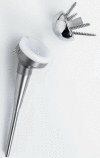Reverse total shoulder replacement: intraoperative and early postoperative complications
- PMID: 18685908
- PMCID: PMC2600997
- DOI: 10.1007/s11999-008-0406-1
Reverse total shoulder replacement: intraoperative and early postoperative complications
Abstract
Reverse total shoulder arthroplasty is a treatment option for patients with symptomatic glenohumeral arthritis and a deficient rotator cuff. The reported complication rates vary from 0% to 68%. Given this variation, our purposes were to (1) determine the learning curve for the procedure, (2) identify complications and surgical pitfalls, and (3) compare our results with those of similar published series. We retrospectively reviewed 20 consecutive patients (mean age, 73 years; range, 45-88 years) who had reverse total shoulder arthroplasty by one surgeon, tabulating intraoperative and postoperative complications. Minimum followup was 3 months (average, 9 months; range, 3-21 months). The intraoperative complication rate for the first 10 patients was higher than that for the second 10 patients. There were 33 complications in 15 patients: 11 patients collectively had 22 intraoperative complications and eight patients collectively had 11 postoperative complications. At radiographic followup, 11 patients had scapular notching and nine patients had heterotopic ossification. Our complication rate was higher than published rates.
Level of evidence: Level II, prognostic study. See the Guidelines for Authors for a complete description of levels of evidence.
Figures



References
-
- {'text': '', 'ref_index': 1, 'ids': [{'type': 'DOI', 'value': '10.1016/j.jse.2004.10.006', 'is_inner': False, 'url': 'https://doi.org/10.1016/j.jse.2004.10.006'}, {'type': 'PubMed', 'value': '15726075', 'is_inner': True, 'url': 'https://pubmed.ncbi.nlm.nih.gov/15726075/'}]}
- Boileau P, Watkinson DJ, Hatzidakis AM, Balg F. Grammont reverse prosthesis: design, rationale, and biomechanics. J Shoulder Elbow Surg. 2005;14(1 suppl S):147S–161S. - PubMed
-
- {'text': '', 'ref_index': 1, 'ids': [{'type': 'PubMed', 'value': '11866145', 'is_inner': True, 'url': 'https://pubmed.ncbi.nlm.nih.gov/11866145/'}]}
- Boulahia A, Edwards TB, Walch G, Baratta RV. Early results of a reverse design prosthesis in the treatment of arthritis of the shoulder in elderly patients with a large rotator cuff tear. Orthopedics. 2002;25:129–133. - PubMed
-
- {'text': '', 'ref_index': 1, 'ids': [{'type': 'DOI', 'value': '10.1017/S0266462307070341', 'is_inner': False, 'url': 'https://doi.org/10.1017/s0266462307070341'}, {'type': 'PubMed', 'value': '17493312', 'is_inner': True, 'url': 'https://pubmed.ncbi.nlm.nih.gov/17493312/'}]}
- Cook JA, Ramsay CR, Fayers P. Using the literature to quantify the learning curve: a case study. Int J Technol Assess Health Care. 2007;23:255–260. - PubMed
-
- {'text': '', 'ref_index': 1, 'ids': [{'type': 'PubMed', 'value': '14748103', 'is_inner': True, 'url': 'https://pubmed.ncbi.nlm.nih.gov/14748103/'}]}
- De Wilde L, Sys G, Julien Y, Van Ovost E, Poffyn B, Trouilloud P. The reversed Delta shoulder prosthesis in reconstruction of the proximal humerus after tumour resection. Acta Orthop Belg. 2003;69:495–500. - PubMed
-
- {'text': '', 'ref_index': 1, 'ids': [{'type': 'DOI', 'value': '10.1097/01.blo.0000146741.83183.18', 'is_inner': False, 'url': 'https://doi.org/10.1097/01.blo.0000146741.83183.18'}, {'type': 'PubMed', 'value': '15662318', 'is_inner': True, 'url': 'https://pubmed.ncbi.nlm.nih.gov/15662318/'}]}
- De Wilde LF, Plasschaert FS, Audenaert EA, Verdonk RC. Functional recovery after a reverse prosthesis for reconstruction of the proximal humerus in tumor surgery. Clin Orthop Relat Res. 2005;430:156–162. - PubMed
MeSH terms
LinkOut - more resources
Full Text Sources
Medical
Research Materials

